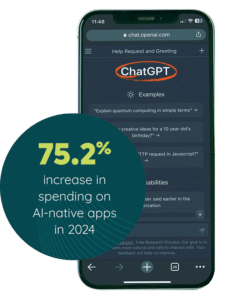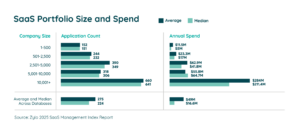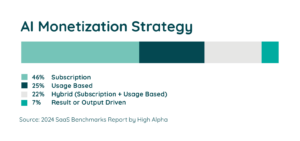Table of Contents
Artificial intelligence is no longer a futuristic concept. It’s a present-day force reshaping how software is built, deployed, and used. Nowhere is this transformation more visible than in SaaS. From streamlining operations to predicting user needs before they arise, AI-powered SaaS platforms are enabling organizations to move faster, work smarter, and make more informed decisions.
As AI becomes a standard component across software stacks, the competitive advantage lies not just in adopting the technology, but in understanding how it’s driving real business value. In this article, we will explore how AI is transforming the SaaS industry—from the technologies that enable it to the challenges it presents—and what it means for the future of software.
What Is AI in SaaS?
Artificial intelligence in SaaS refers to the integration of machine learning, automation, natural language processing, and data analysis within cloud-based software applications. These capabilities allow SaaS platforms to perform tasks, learn from data, make decisions, and continuously improve outcomes over time. Unlike traditional software, AI-enhanced SaaS adapts dynamically to user behavior and business needs, delivering smarter insights and more efficient operations.
AI in SaaS can power everything from intelligent automation to personalized recommendations, often running quietly in the background to optimize performance. Whether surfacing actionable data or handling customer queries through AI assistants, these tools are reshaping how businesses work, innovate, and interact with technology on a daily basis.
Why AI Matters in SaaS Today
Artificial intelligence isn’t just another tech trend. It’s quickly becoming the backbone of modern SaaS. As companies look to do more with less, AI delivers on that promise by helping software work smarter behind the scenes. It powers better recommendations, faster decisions, and more efficient workflows, turning SaaS from a static tool into an active business partner.
 The impact is showing up everywhere. SaaS platforms with built-in AI features are improving productivity, reducing costs, and even uncovering risks before they happen. According to Zylo’s 2025 SaaS Management Index, spending on AI-native apps jumped over 75% in the past year alone.
The impact is showing up everywhere. SaaS platforms with built-in AI features are improving productivity, reducing costs, and even uncovering risks before they happen. According to Zylo’s 2025 SaaS Management Index, spending on AI-native apps jumped over 75% in the past year alone.
That’s not just growth—it’s a signal. 77.6% of IT leaders report upgrading or investing more in SaaS apps for their AI capabilities over the past year. Businesses are betting big on AI because the returns go beyond automation. They’re seeing tangible outcomes in speed, accuracy, and innovation.
AI Technologies Transforming SaaS
Artificial intelligence in SaaS isn’t one thing—it’s a collection of powerful technologies working together. From automation to advanced analytics, these tools are redefining what software can do. Below are some of the most influential AI capabilities reshaping SaaS today.
Machine Learning
Machine learning (ML) is the foundation of most AI-driven SaaS tools. It enables platforms to spot patterns in massive datasets and learn over time. For SaaS vendors, this means smarter features that adapt to user behavior without manual programming. ML is behind things like churn prediction, usage forecasting, and intelligent license management—core components in tools like Zylo’s SaaS discovery engine.
Natural Language Processing (NLP)
Natural Language Processing (NLP) enables software to understand, interpret, and generate human language. In the SaaS world, NLP powers capabilities like intelligent chatbots, automated document summarization, contract analysis, and enhanced search functions. By allowing platforms to process natural user inputs, NLP enhances user interaction with software and helps surface valuable insights hidden in unstructured text data.
Predictive Analytics
Predictive analytics uses historical data and statistical modeling to anticipate future outcomes. In the SaaS industry, it powers capabilities like predicting customer churn, optimizing product roadmaps based on usage patterns, and forecasting demand for new features. By turning past behaviors into forward-looking insights, predictive analytics helps SaaS providers make smarter strategic decisions and deliver more targeted, effective services.
Automation
AI-driven automation is where productivity gains start to really show. From onboarding workflows to license deprovisioning, automated tasks save time and reduce human error. Tools that can take repetitive tasks off your plate are fast becoming a must-have, especially as portfolios grow. Our research reveals that companies now average 275 SaaS applications, making automation a critical part of scaling operations without adding headcount.

Benefits of AI in SaaS
AI is redefining what SaaS can deliver—not just in speed or automation, but in how intelligently software supports users and business goals. These benefits compound as AI matures, helping companies scale without chaos, reduce waste, and build better user experiences at every touchpoint.
Personalization That Actually Works
SaaS platforms with AI learn from behavior over time, making it easier to tailor interfaces and recommendations. This personalization isn’t limited to surface-level tweaks. It can adapt workflows based on user roles, preferences, or past activity, helping employees get more done with less friction. It’s especially useful in platforms supporting large, diverse teams where one-size-fits-all just doesn’t work.
Improved Customer Engagement
Personalized experiences lead to stronger engagement. AI tools analyze when and how users interact with features, helping teams identify drop-off points and improve onboarding. Some SaaS platforms use these insights to trigger outreach or in-app nudges. By optimizing touchpoints, companies can reduce churn and extend product value, without waiting for a support ticket to come in.
Recommending Smarter User Actions
Beyond personalization and engagement, AI is stepping into the role of a strategic assistant. Think of platforms like Zylo Insights, which uses AI to surface hidden SaaS apps and recommend cleanup or consolidation opportunities. These aren’t passive alerts—they’re action-ready insights that help teams focus on what matters most.
Predictive Insights Without the Guesswork
Predictive insights are changing how SaaS companies deliver value—not just by forecasting trends, but by actively shaping user experiences. Today, AI models help platforms personalize feature recommendations based on user behavior, predict support needs before customers encounter issues, and even identify which accounts are likely to expand. By turning patterns into actionable strategies, predictive insights allow SaaS providers to move from reactive service to proactive growth.
Smarter Cybersecurity Practices
With AI tools handling sensitive data and making decisions, security must keep pace. Today, 89.4% of IT leaders surveyed have concerns about the security risks associated with AI tools (SMI). Many SaaS platforms now embed AI features to detect anomalies, enforce governance rules, or manage compliance automatically. For example, Zylo’s governance-focused features help IT leaders stay aligned with policies while keeping up with rapidly evolving software environments.

Faster, Friendlier Customer Support
AI-powered support tools, like chatbots and intelligent ticket routing, are now the front line for many SaaS companies. These systems can resolve common issues quickly and hand off more complex ones without losing context. That reduces wait times and improves resolution quality—two things users care about more than they might admit.
Scaling Without Losing Control
Managing a few tools is easy. Managing hundreds? That’s where AI shines. It handles repetitive tasks like license tracking or application categorization automatically. This lets teams scale their SaaS operations without matching every app with a new hire. While 81.8% of IT leaders reported having documented policies specifically governing the use of AI tools, it can be hard to keep up. With Zylo’s SaaS Visibility, companies gain real-time clarity and keep overhead low.
Driving Innovation at Every Level
Lastly, AI isn’t just improving what software does—it’s pushing boundaries. It’s behind the shift from seat-based licenses to usage-based pricing and is unlocking entirely new use cases, from automated video generation to AI-led software development. Forward-looking SaaS companies are already building these capabilities into their products, setting the stage for the next generation of solutions.
Use Cases for SaaS AI Tools
The real power of AI in SaaS comes through in how it’s applied across departments. From marketing to customer support, AI-enabled tools are helping teams make faster decisions. It also helps personalize user experiences and reduce manual effort at a scale that would often be impossible otherwise. McKinsey notes that half of respondents say their organizations have adopted AI in two or more business functions, up from less than a third of respondents in 2023.
Smarter Marketing Campaigns
AI takes the guesswork out of targeting. It can segment audiences, test messaging variations, and even adjust ad spend based on real-time performance. Many marketing platforms now use AI to optimize campaigns automatically—identifying high-converting channels and suggesting next steps. This saves time and ensures budgets are used more effectively. Tools like Zylo can also support marketing ops teams by showing how SaaS marketing spend aligns with actual usage and ROI.
Better Data Analytics and Reporting
SaaS analytics tools have evolved from static dashboards to dynamic, AI-powered insights. Rather than pulling manual reports, teams can now rely on platforms that surface trends, detect anomalies, and even recommend optimizations. For example, Zylo’s SaaS Spend Management combines AI financial discovery with robust usage data to help finance and procurement teams find savings opportunities in real time.
More Effective Customer Relationship Management
CRM platforms powered by AI can do more than track interactions—they can predict churn, recommend upsells, and automate follow-ups. These systems help sales and customer success teams prioritize the right accounts and actions based on probability, not gut instinct. And with so many CRMs now offering AI assistants, it’s easier to surface the insights that actually drive retention.
Automated Customer Support and Chatbots
Chatbots are no longer just helpdesk novelties. They’re becoming smarter, context-aware, and far more effective at resolving issues. By referencing historical data and conversation patterns, AI support tools can often anticipate a user’s needs and offer solutions proactively. This is especially useful for high-volume environments where scaling human support isn’t feasible.
Dynamic Pricing Optimization
AI can help fine-tune pricing models based on user behavior, demand, and competitor benchmarks. For SaaS companies with tiered or usage-based pricing, this ensures plans stay competitive while maximizing revenue. AI-driven pricing also helps procurement teams negotiate better contract terms by forecasting renewal impact based on changing usage trends.
Smarter Product Development
By analyzing feature usage and customer feedback, AI helps product teams prioritize updates based on what matters most to users. Some platforms even use AI to prototype or A/B test new features before full-scale release. This kind of rapid iteration allows SaaS companies to stay ahead of customer needs while reducing the risk of misfires.
Employee Training and Onboarding
AI tools can personalize training paths, detect knowledge gaps, and deliver bite-sized learning based on role or skill level. This is particularly helpful in complex SaaS environments where onboarding traditionally takes weeks. Smarter onboarding doesn’t just speed up ramp time—it helps teams retain more information and use software more effectively from day one.
Streamlined Project Management
SaaS platforms that support collaboration and task management are also getting an AI boost. Think automated timeline adjustments, task suggestions, and intelligent workload distribution. AI takes pressure off project leads by identifying bottlenecks before they slow things down, keeping teams aligned and projects on track.
Examples of AI SaaS Companies
From productivity to analytics to customer experience, AI-driven SaaS companies are leading innovation across every corner of the software market. The number of SaaS companies monetizing AI features increased 9% in 2024, with 68% of respondents reporting that revenue expansion opportunities are driving their AI strategy. Among SaaS companies that monetize AI features, 25% employ usage-based pricing, and 22% use a hybrid strategy, combining both subscription- and usage-based models.

These tools aren’t just layering AI on top—they’re embedding it into the very foundation of their platforms.
- Zoom: Uses AI to generate meeting summaries, live transcriptions, and real-time translation, helping users stay productive and collaborative across time zones.
- Slack: AI features assist with summarizing long conversations, surfacing action items, and helping teams cut through noise in fast-moving channels.
- Grammarly: Powered by advanced natural language processing, Grammarly’s AI helps improve clarity, tone, and engagement in written communication.
- Zendesk: Integrates AI to route tickets, suggest help articles, and automate resolutions—dramatically improving support efficiency and customer satisfaction.
- HubSpot: Offers AI-powered content creation, predictive lead scoring, and marketing automation that adapts in real time to user behavior.
- OpenAI (ChatGPT / API): Many SaaS companies integrate OpenAI’s API to power their own generative capabilities, from virtual assistants to code generation tools.
- Docusign: Uses AI to identify contract risks and automatically extract key data, streamlining the agreement lifecycle.
- Intercom: Known for its FinAI agent, Intercom combines conversational AI with robust analytics to guide customers through complex issues.
- Gong: Analyzes sales conversations with AI to uncover trends, suggest improvements, and forecast deal outcomes.
- Jasper: An AI writing assistant that helps marketing teams create and refine content faster, backed by contextual learning from brand voice data.
- Notion: Uses generative AI to summarize notes, generate project briefs, and help users structure information more efficiently.
- Shopdesk: An emerging AI-powered retail operations tool that helps manage inventory, customer data, and sales forecasting.
- Copy.ai: Provides marketing teams with automated copywriting tools that adapt to tone, context, and platform formats.
- Weights & Biases: A platform that helps machine learning teams track experiments, visualize models, and collaborate on AI projects.
These companies are just a sampling of what’s possible when AI becomes a core part of software and not just a bolt-on feature. The most effective tools use AI to reduce friction, automate complexity, and offer insights that would otherwise take hours of manual effort.
Risks and Challenges of AI in SaaS
AI brings clear advantages to SaaS, but it also introduces complexity, risk, and tough questions about governance, ethics, and trust. As organizations adopt more AI-powered tools, understanding these challenges is essential for managing long-term value and avoiding costly missteps.
Shadow AI: The Invisible Threat
Shadow IT isn’t new, but Shadow AI takes it to another level. Employees now use AI tools, like ChatGPT or browser-based assistants, without approval or oversight. These tools often operate outside IT’s visibility, making it harder to assess risk or ensure compliance. According to our findings, 33.6% of SaaS applications are introduced through employee-led purchasing, with many falling into AI-native or AI-assisted categories.

Data Privacy and Leaks
AI systems require large volumes of data to learn and improve. That makes them inherently risky when it comes to privacy and data security. If improperly configured, they can store or process sensitive information in ways that violate internal policies or regulations. Some platforms even retain data inputs for future model training. Without tight controls, the risk of exposing personally identifiable or proprietary information goes up significantly.
Bias in AI Models
AI systems are only as good as the data they’re trained on. Bias—whether from skewed training sets or incomplete feedback loops—can lead to inaccurate or even harmful outcomes. In SaaS platforms, that might mean biased recommendations, unfair scoring models, or misclassified data. Responsible vendors are now prioritizing fairness in AI, but without transparency, it’s hard for end users to verify what’s happening behind the scenes.
Integration with Legacy Systems
Not every organization is ready to adopt AI tools overnight. Legacy systems often lack the APIs or infrastructure needed to fully integrate with modern AI SaaS platforms. This can result in fragmented workflows, duplicated effort, or data silos—ironically making things less efficient. Companies must weigh the cost of integration against the value of AI before making the leap.
Lack of Skilled Talent
AI is evolving faster than most teams can keep up. From implementation to oversight, organizations need skilled professionals who understand how AI works, where it adds value, and how to manage it responsibly. But those professionals are in short supply. Without them, companies risk misconfiguring tools, misinterpreting data, or simply not using AI to its full potential.
Managing Customer Expectations
There’s a growing gap between what AI tools promise and what they can reliably deliver. Overhyped features or vague claims can lead to user disappointment, lower adoption, or missed goals. Companies must be transparent about what AI can and can’t do—and make sure internal stakeholders know how to use it effectively.
Evolving Regulatory Pressures
Regulatory guidance around AI is still taking shape. New rules on AI use, explainability, and ethical deployment are emerging in the U.S., EU, and beyond. SaaS vendors must prepare for this shifting landscape by building AI governance into their core practices. Otherwise, they could face compliance gaps that slow down innovation or open the door to legal risk.
How to Overcome AI Challenges in SaaS
The risks of AI in SaaS are real, but they’re not dealbreakers. With the right strategies in place, companies can embrace AI’s potential while minimizing its pitfalls. It starts with visibility and grows into a culture of governance, accountability, and continuous improvement.
First, companies need to get a handle on what tools are in use, who owns them, and how data flows between systems. Solutions like Zylo’s SaaS Governance platform help organizations establish policies, manage vendor risk, and monitor usage across the entire environment. This foundation makes it easier to spot shadow AI, enforce data privacy standards, and ensure applications are secure and compliant from day one.
Equally important is building cross-functional alignment. IT, procurement, legal, and business teams must work together to evaluate new tools, assess ethical implications, and track outcomes. As AI becomes embedded in more workflows, success depends less on the tech itself and more on how it’s managed. With training, transparency, and a strong governance framework, companies can unlock AI’s value while keeping control where it belongs.
The Future of AI in SaaS: Generative AI and Beyond
AI in SaaS isn’t slowing down—in fact, it’s just getting started. Generative AI has opened the door to entirely new workflows, reshaped how users interact with software, and introduced business models that didn’t exist a few years ago. As this technology matures, we’re likely to see it touch every layer of the SaaS stack, from user interface to backend infrastructure.
Evolution of AI-Driven SaaS Products
Early AI features were bolt-ons—chatbots here, auto-complete there. Now, SaaS products are being rebuilt from the ground up with AI at the core. Tools like Zylo are using AI to drive discovery, flag risk, and reduce costs automatically. In the future, these platforms will grow even more autonomous, acting less like dashboards and more like virtual assistants that manage, recommend, and act on behalf of users.
AI and IoT: Smarter Together
As Internet of Things (IoT) devices generate more data, SaaS platforms will play a key role in interpreting and responding to that data in real time. AI will enable SaaS tools to orchestrate connected systems—automating tasks based on real-world signals, from predictive maintenance to inventory restocking. This cross-pollination will likely lead to a new wave of vertical SaaS platforms specialized for logistics, manufacturing, and healthcare.
The Growing Role of AI in Cybersecurity
With cyber threats evolving just as fast as the tools designed to stop them, AI is quickly becoming a frontline defense. SaaS vendors are embedding AI to detect anomalies, enforce policies, and even respond to incidents. As more applications move to usage-based models, expect to see tighter integration between AI and governance systems like Zylo’s risk mitigation platform to automatically flag and remediate risky behavior.
The Rise of Agentic AI: Autonomous Strategy
Agentic AI is the next step forward. These tools go beyond pattern recognition and prediction; they take initiative. They make decisions, coordinate with other tools, and adapt over time without constant human input. Think AI assistants that not only flag an underused app but suggest cancellation, draft the vendor email, and route it for approval—all without being asked. This level of autonomy could redefine how we think about workflows altogether.
What’s Next: Predictions from the Frontlines
Looking ahead, we expect three big shifts:
- Generative AI will be embedded into more day-to-day business tools—not just writing and design apps, but CRMs, HR systems, and procurement platforms.
- AI usage will become a key metric in SaaS value evaluation, affecting renewals, pricing, and vendor relationships.
- Responsible AI will become a competitive differentiator, with buyers demanding transparency, accountability, and strong governance baked into every product.
AI won’t replace SaaS. It will redefine it—from passive systems that store data to active partners that drive outcomes.
Preparing for What’s Next with Zylo
AI is transforming the software industry—and with it, the way companies manage software. From smarter spend management to automated SaaS discovery, AI is helping businesses work faster, make better decisions, and stay ahead of risk. But as AI becomes more embedded in SaaS tools, it also introduces new layers of complexity, cost, and security challenges that can’t be ignored.
That’s where Zylo comes in. With a platform built to uncover hidden apps, eliminate waste, and support governance at scale, Zylo helps organizations make the most of their SaaS investments—especially as AI reshapes the market. Whether you’re navigating AI-driven pricing models, identifying risky applications, or looking for new ways to optimize usage, Zylo gives you the visibility and control to act with confidence.
Ready to see how AI fits into your SaaS strategy? Explore Zylo’s solutions to take the next step.

